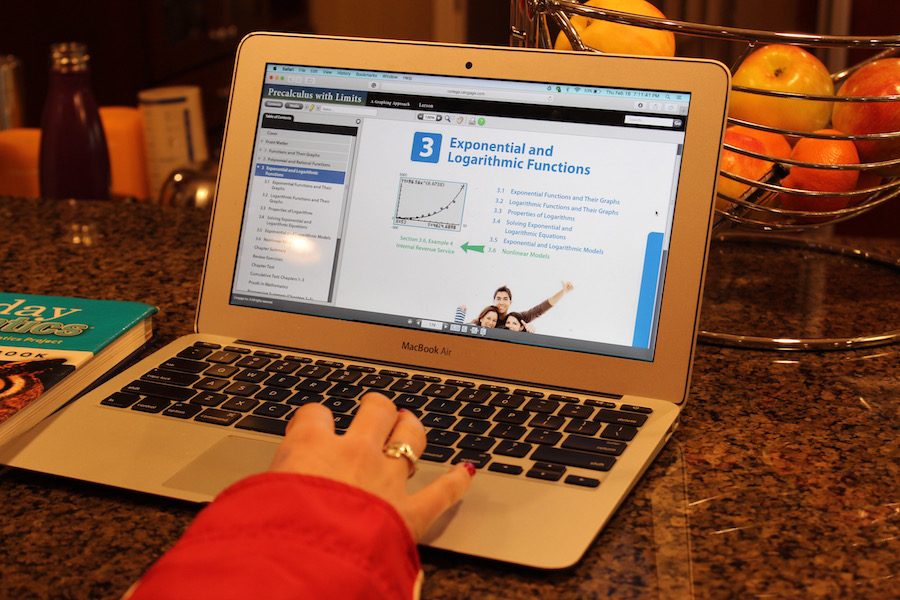Electronic devices are changing the way students learn in the classroom
Whether it be projection boards for teacher lectures, online teacher portals to access assignments, or fun study games in class, technology plays a huge part in learning today.
By using electronic devices as learning tools, students are learning more at a rapid pace.
Kahoot, Pear Deck, PowerSchool, databases: these online applications are only a few of the most common among the many that students at BSM utilize in class. With the one-to-one laptop program, technology plays a prominent role in the curriculum as teachers find new ways to use it.
Currently, students find that a variety of classes implement technology, but the subject that many students agree that uses it the most is English. With Pear Deck available for discussions on literature, English lends itself to use technology in class. Outside of class, typing essays and using the Internet for research make English a natural subject to use technology for.
Other subjects implement technology as well. Many classes have lectures, allowing students to use their laptops to store notes. “[Some teachers], post notes so if you miss class, you have them on the computer, so that you can go back and look at them,” sophomore Kennedy Harris said.
A commonly used application that students and teachers use at BSM is Haiku, which allows students to view coursework. This allows students to access files for their laptop and see the due dates and tests that teachers have. “I’ve never found a better way than Haiku to figure out how homework is done, and I feel like teachers have done a really good job of figuring out how to properly use Haiku,” senior Chaz Linder said.
Most classes also include projects that allow students to use various applications. “[Technology’s] definitely useful in doing projects, like iMovie. In religion, we had to do a movie, so iMovie was nice,” freshman Sophie Latourelle said.
Two popular applications used in classes for review are Kahoot and Quizlet Live. These two games use laptops to let students compete in a review game and see who can get the most points. “Test reviews, like Quizlet Live [are great] because everybody loves [it], it’s competitive and fun, and you get something out of it,” Latourelle said.
Despite many classes effectively utilizing BSM’s one-to-one laptop program, some students find that there is room for improvement. Sometimes, rather than using technology for educational purposes, students can be distracted using it for their personal use. “A lot of times [laptops] help students, but on the other hand it can [let them] play games,” Latourelle said.
Students tend to be split on how much technology helps with regards to online textbooks. Some students find that their classes are easier since they have access to textbooks on their laptops instead of needing a hard copy. Others say that online textbooks aren’t accessible for some of their classes. “[Teachers should] make all of their textbooks PDF-available,” Linder said.
The possibility of students becoming distracted by their laptops can sometimes make it difficult to decide how much freedom can be given to students with this technology. Restrictions on students’ ability to use their laptops can hinder some that want to use them for class. “[In one class] I was really wanting to take notes on my computer because I feel like it goes faster, and [my teacher] said I can’t use my computer,” Harris said.
Looking into the future, students have different ideas for how the extended use of technology will impact education. Two similar developments that students predict are virtual reality and holograms. Many think that they will bring the classroom to life, such as by demonstrating photosynthesis in biology or creating immersive activities for students to use.
However technology in the school changes, it will most likely create a more interactive, immersive environment for students. Many students believe that the school will have more activities such as games that will help with learning.






































![Teacher Lore: Mr. Hillman [Podcast]](https://bsmknighterrant.org/wp-content/uploads/2025/03/teacherlorelogo-1200x685.png)





Josh King • Mar 2, 2017 at 10:29 am
I believe that technology in the classroom is on the rise and for a good reason, I feel that it helps the students reach their full potential as to how much they take in from the lecture or presentation.
Sydney • Mar 2, 2017 at 10:28 am
I enjoyed reading your article. My high school has also started to integrate new technology into the classroom. I think that you made good claims about both the pros and cons of using laptops in class. There are many of the same programs that your school uses as mine but there are also a few that I have never heard of. I am looking forward to seeing how the programs that I have not heard of work.